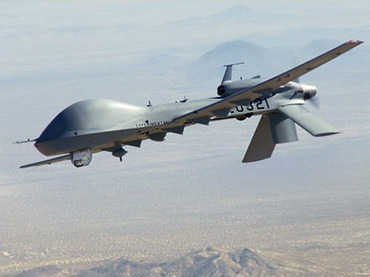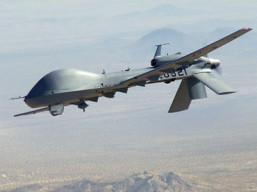
CIA drones pounded Pakistani soil with renewed intensity during the first month of 2013, according to the Bureau of Investigative Journalism’s monthly report based on the ‘Covert Drone War’ project.
In a jarring display that fuelled the recent, heightened spate of violence in Pakistan, January saw six drone strikes in merely nine days – a number exceeded only by August 2012. Compared to the January of last year, the number of strikes doubled this year.
The report also covered Yemen and Somalia. Yemen saw eight drone strikes during the month, with none of them confirmed as US attacks. No operations were reported in Somalia.
In Pakistan, there have been a total of 362 US drone attacks since 2004 – most of them during the tenure of incumbent President Barack Obama: 310 or 85.6%.
Although it is difficult to ascertain the exact number of casualties, the Bureau believes 2,629 to 3,461 people were killed and 1,267 to 1,431 wounded. Of the total fatalities, 475 to 891 were civilians, including 176 children.
High-value hits
The January drone strikes killed 27 to 54 people, of which 0 to 2 were reportedly civilians. Three senior, high-value militants were also successfully hit.
The very first strike of the month killed prized target Mullah Nazir. Nazir had been on the CIA hit-list for a long time, and had been involved with multiple attacks on Nato and Afghan forces in Afghanistan.
Tehreek-e-Taliban (TTP) commander Wali Muhammad Mehsud was also killed during the month, as was senior al Qaeda commander Sheikh Yaseen al Kuwaiti, reportedly hit by eight missiles while at home with daughter and wife.
The Taliban characterised
The report also indicated a supposed classification of the Taliban into two categories – ‘good’ and ‘bad’ – by the Pakistani military and intelligence community. Maulvi Nazir was apparently labelled as one of the ‘good’ Taliban because his group did not carry out terrorist attacks within the country. Following the same line of reasoning, the TTP emerged as the ‘bad’ Taliban, responsible for numerous bloody attacks in Pakistani cities.
Brigadier Asad Munir, a retired commander of the Inter-Services Intelligence (ISI), has predicted that Nazir’s death may cause problems for the capital. Pakistan’s army cannot engage in combat with both ‘good’ and ‘bad’ Taliban at the same time, making peace dialogue with the ‘good’ Taliban essential.
Public response
Another distinguishing factor for the month of January was the muted public response against the drone strikes. In 2012, angry protests and loud displays of widespread public condemnation followed almost every strike. The year 2013 did not start off with the same response.
According to the Bureau, the improvement in US-Pakistan relations – complemented by the Mehsud’s killing, something that appeased Islamabad – may have influenced countrywide reactions.
Furthermore, the CIA also announced adding Maulana Fazlullah, commander of Swat Taliban, a group that claimed responsibility for shooting Malala Yousufzai, on the hit-list. Islamabad has long been calling on Nato and Afghan forces to take action against the particular outfit.
Published in The Express Tribune, February 2nd, 2013.
COMMENTS (18)
Comments are moderated and generally will be posted if they are on-topic and not abusive.
For more information, please see our Comments FAQ





















1714029027-0/Tribune-Collage-Feature-Images-(11)1714029027-0-270x192.webp)
1714027629-0/Ranbirtransformation-(1)1714027629-0-270x192.webp)





















Good or bad Taliban are a curse, drones will follow them like evil spirit wherever they go, Evan at Karachi.Sooner or latter they wud.
@B: this beauty and state-of-art bird will be flying over USA/NATO countries soon,history always repeat itself.
"Islamic terrorism" is the invented excuse. John Pilger: Read more: http://www.iraqwar.mirror-world.ru/article/285250
In accordence with the media report, rights groups and the United Nations have censured United States drone attacks, stressing that the raids flouts international law.
I would like to say herein, United Nation long live,long live United Nations.
heard a good news which made my mood delightful.
Inspite of condemnation on the world level state-depart is not going to stop drone invasions on Pakistan's particular areas and in Yemen,Somalia.
According to the American stance in this regard,United States,as its leaders saying,it needs to continue against what they called terrorists.not only in Pakistan but also in Yemen and Somalia.
After,more than a decade long conflict US come to the conclusion that drone as a vital weapon in hand they can face insurgency in the world.
As for as drone is concened,state depart understand it indispensable for American defence .
As regards, counter insurgency,Pakistan repeatedly requested for with details but they set asid.
It looks as Pakistan has been compelled to see other options.
@Anam H: Wow, please provide credible references to support your view that "thousands" of innocents have been killed to get just one terrorist! AND Please provide us with the names of those cities "bombed" to get just "ONE terrorist" so we can all check on your allegations!
SO, what all these comments are suggesting, is that; it is OKAY to bomb cities, killing thousands of innocent men, women and children, in the hopes of catching ONE terrorist. OBAMA- the man who cried at the killing of a few Children of Sandy Brook Elementary- finds this totally normal, if not great. In his view the death of million innocents (as long as they aren't Americans) does not matter, as 'hopefully' one terrorist might die. America has no right to threaten Pakistan's sovereignty like this.
If Pakistan quit providing sanctuary to terrorist here would be no need for drones. How about doing the World and yourselves a favor and take back control of Pakistan and kick out the terrorist? No one outside of Pakistan has sympathy for your bogus "sovereignty" argument and while much is made of civilian casualties most would agree that drone attacks are the most precise military alternative available and result in far less collateral damage than other alternatives including direct military intervention by Pakistan (which tends to rely heavily on artillery).
Unfortunately the drones are the only thing that is stopping the TTP murderers...the politicians say one thing to appease the religious extremist in Pakistan but they tell the Americans a different story and encourage the drones which are eliminating the real enemy...
@Something Clever: "This is a good example why it’s hard to even care about the statistics. 2,629 – 3,461 1,267 – 1,431 475 – 891" You better care about such statistics; they are flesh-and-blood human beings although most of those targeted do not have any human qualities at all. But, the important thing to take away from such statistics is that the first group ( killed) are about 50% of the second group (wounded). Generally in any offensive action those statistics would be expected to be the other way around. Even more remarkable is third group ( civilians) about 20% of those killed. This proves conclusively how much care is being exercised in targeting to reduce the collateral damage as much as possible. We all should be appreciative of such effort!
What is the use in having an air force when it cannot defend its own territory. Pakistan should outsource its security to China.
Pity. The world's best Army cannot down a drone.
Until and unless Pakistan is haven to terrorist drone attacks will continue.Drone attacks will continue until the last terrorist is killed inside Pakistan.
"Although it is difficult to ascertain the exact number of casualties, the Bureau believes 2,629 to 3,461 people were killed and 1,267 to 1,431 wounded. Of the total fatalities, 475 to 891 were civilians, including 176 children."
This is a good example why it's hard to even care about the statistics. 2,629 - 3,461 1,267 - 1,431 475 - 891 Those are not small ranges. Actually picture just how many people they basically say they're unsure about. Just using those examples, it means there are 1,412 people in those figures that they aren't sure about. They even admit they can't properly get the information required for accuracy. Yet, they and anti-drone people reference those statistics as the foundation of their argument. That's not a small number of people. That's somewhere near a 25% chance for error. You don't quote something like that as factual.
"Islamabad has long been calling on Nato and Afghan forces to take action against the particular outfit."
So here ends the question and issue of drones violating PAK sovereign rights. Hopefully, now PAK understands.
Yesterday I read the News somewhere in PAK Daily New US secretary of state KERYY is very friendly with PAK. and today I'm reading how friendly he is ............